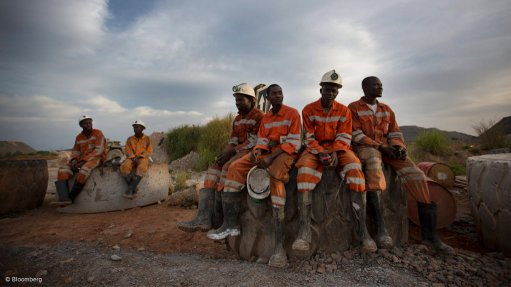
NAIROBI – For the first time in almost a decade, more people are dying in South African mines, the world’s deepest and among the most dangerous.
There were 81 fatalities from January through November, according to data from the Chamber of Mines, an industry lobby group. Harmony Gold Mining Co. reported a death at its Tshepong Mine Thursday, bringing the total to 82. That’s the first increase in nine years, and compares with 73 in 2016, the lowest on record.
South Africa has gone from being by far the deadliest place to work in a mine to ranking near rivals including the U.S. and Canada for fatality rates. Conditions have improved in the decades since whites-only rule ended in 1994 -- a year in which 484 workers died.
The increase in deaths in 2017 “is particularly disappointing given the improvements we have seen over the past two decades,” Charmane Russell, a spokeswoman for the chamber, said by email. “However, as will be noted, there have been a couple of periods where the improving trend plateaued. In each case further thinking has led to new initiatives.”
DIGGING DEEPER
South African miners are having to go deeper in ageing shafts to access additional ore in a country that’s been mined commercially for over a century. Most miners killed this year labored in gold and platinum mines, which can extend more than 2 miles (3 kilometers) underground. They accounted for 57 of 73 deaths in 2016, according to the chamber.
Last year, deaths in gold mines fell 3 percent, while the platinum industry reported a 29 percent increase in deaths, Mineral Resources Minister Mosebenzi Zwane said in January.
While injuries from falling rocks are decreasing, accidents related to seismic activity and rock-bursts -- where rock under pressure explodes -- are on the rise, Russell said.
“Deep-level gold mining is more prone to seismic activity,” said Thomas van den Berg, head of safety and technology at Harmony Gold. “Many accidents are caused not because the systems implemented failed or were insufficient, but the persons required to implement the systems failed to do so.”
Deaths on the job have compounded problems with an already restive workforce and low productivity levels. Sibanye Gold Ltd. and AngloGold Ashanti Ltd. have both objected to the Department of Mineral Resources temporarily halting operations after accidents, while the regulator argues the companies are not following the law. The two companies report among the highest lost-time incident rates and fatality rates for precious metals miners, Bloomberg Intelligence analysts Gregory Elders and Eily Ong wrote in January.
TOUGHER SANCTIONS
Tougher sanctions including holding management personally liable for deaths would compel the companies to spend more money to protect employees, said Peter Bailey, chairman for health and safety at the National Union of Mineworkers, the biggest miners union. “Companies are maximizing profits while violating safety procedures,” he said.
Operators in South Africa still use labor-intensive mining methods such as hand drilling. Miners could reduce fatalities -- and increase profit margins -- by automating their operations. But such a switch is difficult to make and would require thousands of layoffs. The mining industry employs about half a million people, and its blue-collar workforce is the backbone of the country’s labor movement.
“In a country where there’s so much unemployment, where all of us are committed to creating jobs, if you look at the mines that have the lowest fatalities, it tends to be the ones that are more mechanized,” Patrice Motsepe, executive chairman of African Rainbow Minerals Ltd. and South Africa’s richest black person, said on an earnings call in September.